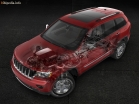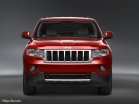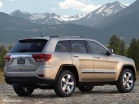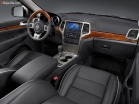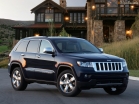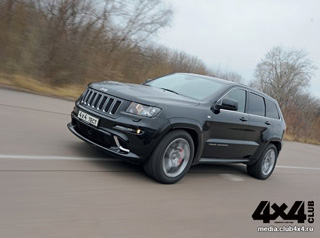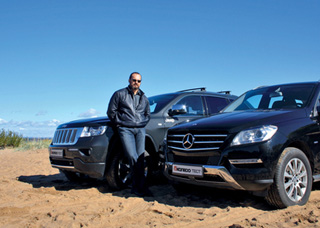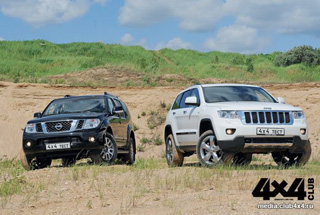Jeep Grand Cherokee test drive since 2010 SUV
The hero of the asphalt
The flagship jeep has significantly improved its road characteristics by bringing the first generation to the Grand Cherokee market back in 1992, marketers made the main emphasis on the off -road qualities of the novelty. It is understandable: under the Jeep brand, exclusively all -terrain vehicles were produced. The exemplary rogue, however, was luxurious and very comfortable, there was a second -generation Grand Cherokee, which debuted in 1998.However, times are changing, and with them market values. Today's premium SUV today is not enough to simply conquer off-road and decently behave on the asphalt from it is expected to be impeccable, almost passenger control. In line with these trends, the current Grand Cherokee, which recently appeared in the salons of Russian dealers, was developed. Preserving all the family traits of Jeep SUVs, the new flagship of the brand was certainly created taking into account modern trends in automobile design, the key concept in which athletism. An elongated hood and powerful wheel arches emphasize the sports character of Grand Cherokee. The car added in size, becoming longer and wider, but slightly lower than the predecessor. The squat body, combined with the expanding ruts of the front and rear wheels, gives the machine a confident appearance and indicates stability on the road. A powerful dynamic look is a higher waist line, and a steep slope of the front racks, and wheels shifted forward from the base of the windshield, which focuses on the motor compartment.
As is appropriate to the luxury car, the luxurious salon of the new Grand Cherokee is distinguished by thoroughly verified ergonomics and the highest quality of performance with touching attention to trifles. For example, seats, specially designed for convenience on long trips, are not only upholstered by the expensive skin of two shades, but also decorated with a embossed Jeep logo. Again, the two -color plastic of the front panel is pleasant to the touch, the details are adjacent to impeccably. The central console is generously decorated with inserts under a tree. The new combination of devices is only four basic scales (speedometer, tachometer and coolant temperature indicators and fuel supply). Compared to the previous version, which included a voltmeter and an indicator of the oil temperature characteristic of SUVs, the panel looks concise and, as it were, lightly.
Due to the extended seats adjustment ranges (longitudinal increased by 50 mm, and vertically moves by 54 mm), almost anyone can comfortably arrange a change in the tilt of the steering column and an electric drive of the pedal node.
It will also be more convenient in the new Grand Cherokee. Their seat became higher (compared to the front seats pillows, the rear sofa is raised by 17 mm), which provides not only the best visibility, but also adds comfort. Here, three adults can accommodate without problems (although together, of course, it is more convenient), however, a large central tunnel from the average passenger is noticeably interfered.
Not without changes in the luggage compartment, where a new double-sided poddon rug appeared: on the one hand, a pile coating, and on the other, easily detergent plastic. For transportation of bulky luggage, the rear seat easily folds in a ratio of 60/40, forming an even roomy cargo platform. Well, small things can be thrown into the trunk through the lifting glass of the fifth door.
However, the most significant audit was not subjected to the exterior and the salon, but by the chassis of the new Grand Cherokee. Previously, the flagship Jeep had uncertain bridges, which was an entirely justified solution for off -road driving, but turned into a lack of handling on asphalt. The latest generation SUV received an independent suspension of the front wheels on two A-shaped levers of unequal length, which provides greater reactivity and rigidity in the transverse direction than a system with an uncertain bridge. The rear wheels suspension are still dependent, but the bridge is now attached to the body using five widely placed levers that limit the twisting of the bridge and increase transverse rigidity. Constructive changes made it possible to reduce the unsubstantiated masses by 45.5 kg, and the total suspension stroke is increased by 29 mm and is 225 mm, which significantly improved the already remarkable smoothness of the Grand Cherokee course. A new steering system has also contributed to the improvement of the road characteristics of the SUV (a gear-rake mechanism with a variable transfer), which is distinguished by the best feedback.
Of course, the revolutionary changes for the Jeep into the design of the chassis did not turn Grand Cherokee into a car, but the controllability of the machine certainly improved. For example, it is much easier to fit into high -speed turns. Compared to the predecessor, the SUV is less fucked and swaying on the waves, and the steering wheel has become sharper and informative.
Brakes that confidently besiege a heavy machine even at high speeds work perfectly. And with the acceleration of Grand Cherokee, especially with a 5.7-liter engine, believe me, everything is in order! The engine developing 326 hp, and an impressive torque of 500 nm accelerate an SUV to 100 km/h in just 7.4 s, and the maximum speed of 208 km/h. In the line of power units of the new Jeep, the 4.7-liter PowerTech V8 motor is also familiar to customers. The engine has undergone modernization and now issues 231 hp. and 410 nm. In addition, in the fall, cars with a new three-liter turbodiesel of the Mercedes-Benz (218 hp and 510 nm) will appear on the Russian market. With the dynamic characteristics comparable to the 4.7-liter engine (maximum speed of 200 km/h, acceleration to hundreds of 9 s) diesel is more economical. In the mixed cycle, the gasoline Grand Cherokee consumes 16 l/100 km, and a diesel 10.2 l/100 km.
But if the efficiency of the diesel engine is perceived for granted, then the fuel consumption indicators of the 5.7-liter HEMI really surprise. Thanks to the MDS system (Multi-Displacement System), which turns off half the cylinders when moving with constant speed and smooth accelerations, fuel efficiency increases by 20% (in the mixed cycle, the SUV eats only 15.4 l/100 km).
However, who is interested in smooth accelerations when the legendary Hemi V8 is under the hood! The pedal to the floor and go. It is a pity that a five-speed automatic gearbox, albeit improved, still did not completely get rid of the delay in the reaction to the operation of the accelerator, still slowed down. But now it can be controlled by automatic and manually. And, we note, the manual mode here is quite honest: the engine is spinning to the stop.
So, on the asphalt, the flagship Jeep behaved well done. It remained to check it on the off -road. We’ll make a reservation right away: an off -road test in the framework of the Russian presentation of the new Grand Cherokee was held on the highway specially prepared by the organizers. As often happens at such events, artificial off -road was created with an unobtrusive goal to emphasize the dignity of the model. In this case, the emphasis was on geometric cross -country ability. Cool hill, demonstrating the corners of the entrance and congress, the movement parallel to the hill slope, overcoming deep potholes test for diagonal hanging
The last exercise should be told in more detail. Thanks to the Quadra-Drive II constant all-wheel drive system, which includes a hand-up box and three high-friction differentials (interdosseous and a pair of inter-circuits), Grand Cherokee is able to continue moving while the grip with soil preserves at least one wheel. Managing the transmission is extremely simple. Only the demultipliter is turned on hand (you need to pull the small lever located next to the machine gun selector), the rest will make electronics. Even the best in these conditions of movement, the car will select the transmission itself (in vain that on a reduced series of automatic transmission automatically goes into manual mode). The driver’s mistakes on the roads can be too expensive to trust the autopilot
Text: Andrey Tsybulsky.
Source: Mkobil magazine [20.06.2005]

